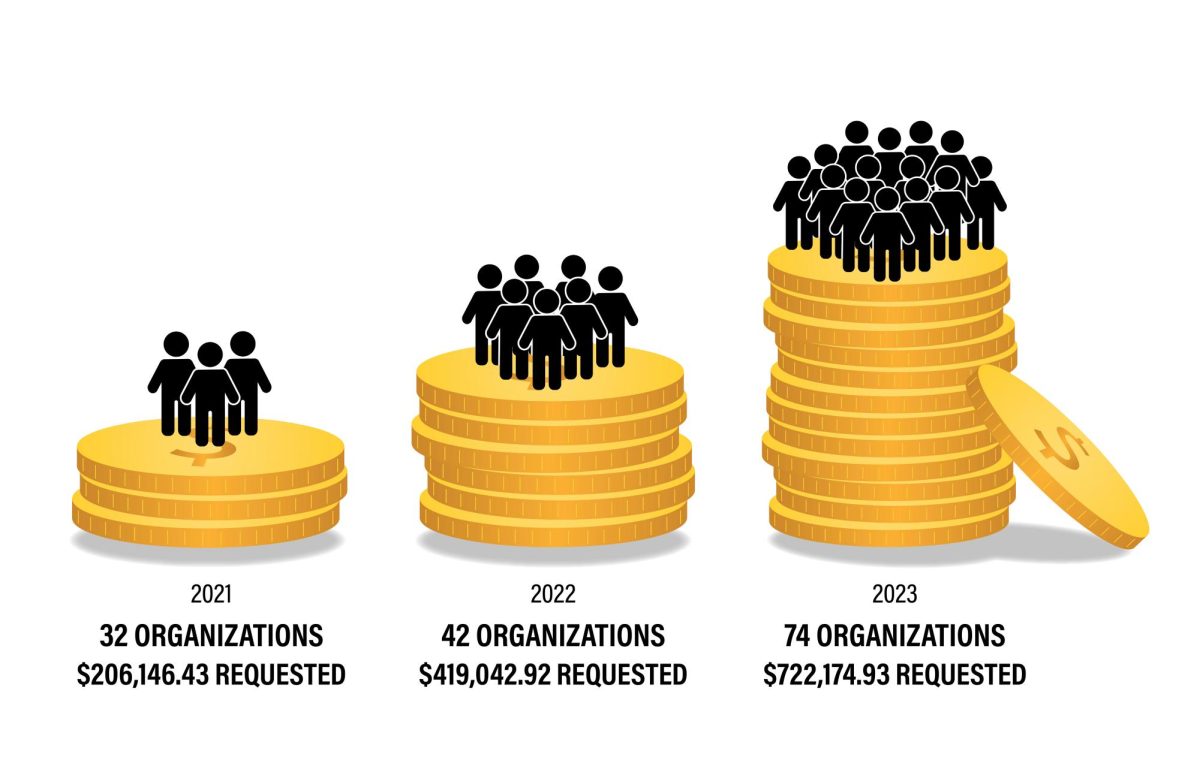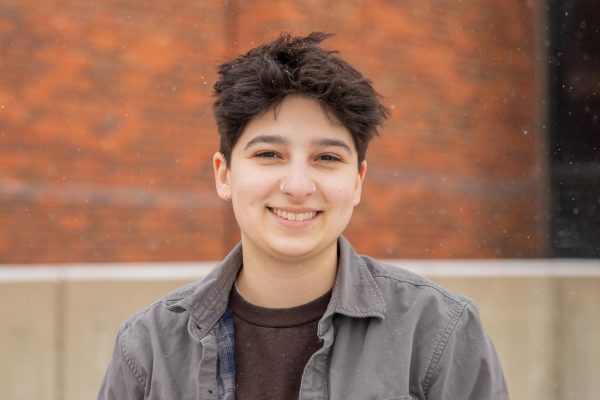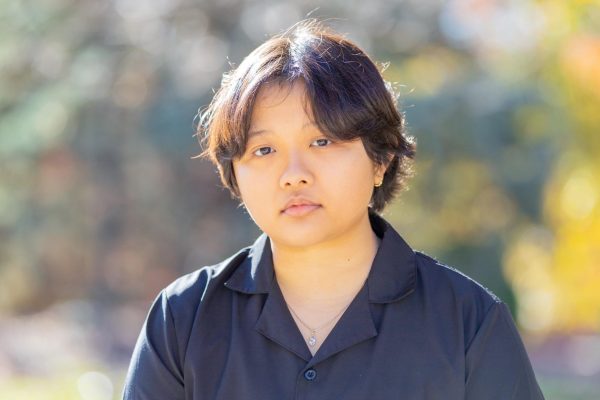Earlier this semester, the Student Government Association went through a several-round process of allocating and reallocating dollars to student organizations. The ever-growing number of student organizations and money requests have spurred conversations in and outside of SGA about adjusting the allocation process.
This year, student organizations, in total, requested over $722,000 worth of funding. Initially, the Student Government Association only had $165,000 to give, which was later upped to $180,000 through reserve money. A week later, an emergency Senate meeting was called to allocate an additional $33,000.
“This is a great year and a great example to recognize we cannot afford this program, yet we also cannot afford to not provide dollars to student organizations because constitutionally we are required to,” Gabriel Fonseca, who helps advise SGA, said at the Aug. 30 Senate meeting.
The Sunflower met with SGA and deans of various colleges on campus to discuss what the future of student organization funding from SGA could look like.
Possibilities going forward
Government Oversight Committee Chairperson Jay Thompson touched on a few ways SGA’s allocation process could proceed. The current process is 3 years old, and according to Thompson, it was created to ensure that smaller groups weren’t left out when asking for money.
In 2021, which was the process’s first year, 32 organizations collectively requested over $206,000; just over $95,000 was allocated.
“For the first year, it worked,” Thompson said. “It was a little confusing, and people didn’t know what was going on, but it worked.”
2022 saw 42 organizations request just under $420,000, with less than half being allocated: $163,000.
This year, though, Thompson said the amount of requests was “incredible, but insane.” Seventy-four organizations went through the allocation process, almost double the past two years. SGA could only afford to fund a quarter of the $722,000 request.
Due to the enormity of requests this year, Thompson laid out some potential solutions to the issue of funding:
Increasing the amount of money for appropriations
To increase the amount of money that the SGA can give in appropriations, the association has to receive more dollars from student fees.
Currently, organizations receive funding from SGA’s budget. SGA receives money for its budget from student fees.
SGA is part of a three-year cycle that has various student support services request a portion of student fee money once every three years. SGA’s last time in the cycle was last year, meaning the association is not scheduled to go up again until 2026.
A rule in SGA’s bylaws permits any entity in the three-year student fees cycle to request a “one-time budget enhancement allocation.” Later this month, SGA leadership will meet to decide if the association wants to request more in student fees to then increase the allocation budget.
“That’s something that joint leadership will have to decide on, which we haven’t had those conversations yet, but I think we’re all in agreement that we’ll have to,” Thompson said.
Thompson said a task force will be put together to help determine how much SGA should request if they go up for the student fee cycle again.
There have been discussions about who to include on the task force, such as past members of student fees committee, previous treasurers and SGA members with emeritus status.
Adopting a cap on funding requests
Thompson discussed potentially capping student funding requests in the allocation process. Currently, there is no limit on the amount that student organizations can request from SGA. Some organizations requested as low as $700 to as high as $75,000 this year.
“I’m sure for the larger groups, that (cap) probably won’t be tiny or anything but still be a good amount of money,” Thompson said. “But caps are necessary so that we don’t have multiple groups requesting $50,000 plus because that’s difficult to fill.”
Splitting the fund for student organizations into categories
As the process currently stands, all organizations are within the same group when it comes to funding requests. Thompson said one way to correct the issue of funding could be to split organizations into categories.
“That could help us not ignore the small groups as much,” Thompson said.
Thompson said that regardless of what the association decides to do, greater participation from the deans of colleges at the university, as well as the university foundation, is necessary moving forward.
Thompson said this would help “alleviate that gap in funding to make sure that these groups don’t have to dissolve.”
Dean responses
The Sunflower reached out to the six major colleges and their deans to ask what financial support has and could look like for organizations under their college. Four of the six deans responded.
The conversation about funding has been “bubbling up” among deans, according to Andrew Hippisley, dean of the Fairmount College of Liberal Arts and Sciences.
“The deans meet once or twice a month, and we discussed this recently,” Hippisley said. “And we all thought, wouldn’t it be good to have SGA in the room and just say, ‘This is the problem we’re trying to solve.’”
Hippisley said while this meeting has not happened yet, it is being arranged.
“The deans and the colleges — They really want this to work.”
College of Engineering
One of the biggest asks in the allocation process this year came from organizations associated with the College of Engineering. Shocker Racing Baja and Shocker Racing Formula SAE requested $42,343.60 and $75,000, respectively. Both organizations received just shy of $20,000 in the final allocation round.
According to both teams in August, the engineering college did not fund either of the groups. College of Engineering Dean Anthony Muscat said future funding will have to be split in some capacity among departments.
“The lion’s share will have to come from the College of Engineering,” Muscat said. “We can’t keep asking the Student Government Association because I met with them, and they made it clear that their funding is limited.”
Muscat said of the 20-plus student organizations under the college, several are supported in various ways.
“Not only monetarily but in staff time,” he said. “We have quite a bit of staff time going to help mentor and coach the student organizations.”
The dean said, while the college wants to support the organizations, there have to be “reasonable plans.” Muscat also talked about having to prioritize where funding goes in the college and what warrants investment.
“The flip side of it is … I don’t want students thinking ‘I can’t participate in this organization because I don’t have the funds,’” he said.
Some of the engineering groups receive chunks of money from outside funding and donations; Muscat said going to companies and fundraising will be one of his priorities this year so that students don’t have to.
“I can’t cover everything, but we are ready to make a commitment,” he said.
Muscat said he’s also asked his staff to help generate ideas for funding to help make future years more predictable.
Fairmount College of Liberal Arts and Sciences
Hippisley said there are 13 student organizations he knows of that fall under LAS. Out of these, Model United Nations had one of the largest funding requests at $42,000. At the end of the allocation process, Model UN came out with $9,970.
“Their numbers have just grown; there are 26 (students) now,” Hippisley said. “They have more students wanting to do it than ever. They never had a budget for that many students.”
Hippisley said LAS offers faculty and staff support to organizations.
“I also chip in money, too, so when organizations don’t have enough,” he said.
Hippisley didn’t outline any potential solutions moving forward but highlighted the importance of conversations between different campus entities.
“We have to be transparent,” Hippisley said. “The students need to know where their fees are going.”
College of Applied Studies
The College of Applied Studies only has one registered student organization that falls into SGA’s allocation process: the Wichita State Counseling Student Association. This group received $1,570 in the final allocation round after initially requesting $7,997.90.
CAS Dean Jennifer Friend said no one from the counseling association has come to her with budgetary concerns.
She said the college’s Department of Intervention Services & Leadership in Education supports this group with “things like arranging venues and helping with planning professional development activities, doing marketing, and encouraging students to attend the activities that the group does.”
College of Fine Arts
Dean of Fine Arts Marie Bukowski responded to The Sunflower but declined an interview, writing via email, “I definitely look forward to a collaboration between the College of Fine Arts and SGA as we move forward. However, at this time, I am not interested in an interview on this topic.”
College of Health Professions
The College of Health Professions did not respond to The Sunflower’s multiple requests to speak.
Barton School of Business
The Barton School of Business did not respond to The Sunflower’s multiple requests to speak.
How to share input
Students or others interested in sharing their thoughts with SGA can do so at the Senate’s public forum. Public forums and the Senate are held every other week on Wednesdays in the Sante Fe Room on the second floor of the Rhatigan Student Center. Meetings start at 6:30 p.m. To sign up for a public forum, visit wichita.edu/student_life/sga.





